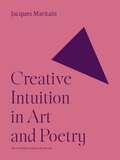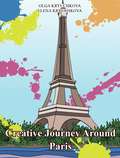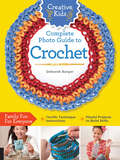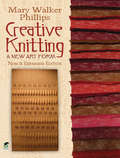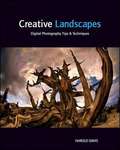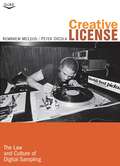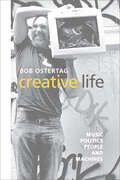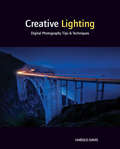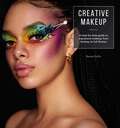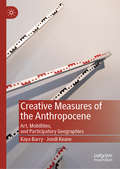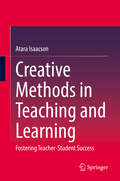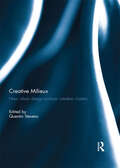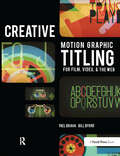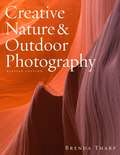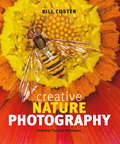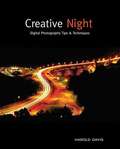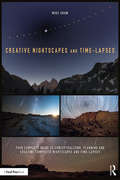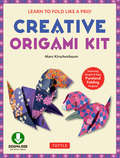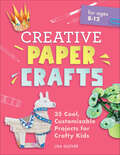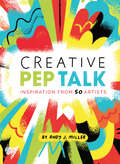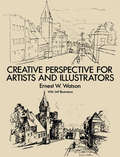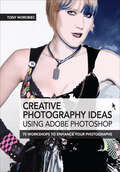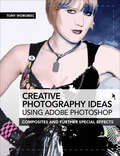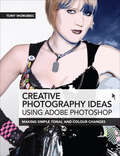- Table View
- List View
Creative Intuition in Art and Poetry (The A. W. Mellon Lectures in the Fine Arts #1)
by Jacques MaritainThe classic work on the sublime interplay between the arts and poeticsThis book explores the rich and complex relationship between art and poetry, shedding invaluable light on what makes each art form unique yet wholly interdependent. Jacques Maritain insists on the part played by the intellect as well as the imagination, showing how poetry has its source in the preconceptual activity of the rational mind. As Maritain argues, intellect is not merely logical and conceptual reason. Rather, it carries on an exceedingly more profound and obscure life, one that is revealed to us as we seek to penetrate the hidden recesses of poetic and artistic activity. Incisive and authoritative, this illuminating book is the product of a lifelong reflection on the meaning of artistic expression in all its varied forms.
Creative Journey Around Paris (Creative antistress books #4)
by Olga Kryuchkova Elena KryuchkovaThis book is devoted to the wonderful views of the French city Paris. Here you will find a coloured image, a brief description about it and an image in black and white. If you want, you can take a screenshot of the black and white image to colour it in on the computer, or print it off and colour it in on paper. You can colour it in identically to the coloured image in the book or choose your own colours for the images yourself. After this you’ll be fascinated to see the real photos of Paris views included in this book. This book will allow you to do art, take a virtual breathtaking tour around Paris and learn new interesting facts. This creative book is suitable for any age. The authors wish you creative success and a pleasant pastime! You can use this book as an antistress colouring or art therapy.
Creative Kids Complete Photo Guide to Crochet
by Deborah BurgerAre you looking for the perfect guide to teach your child to crochet? Look no further! Creative Kids Complete Photo Guide to Crochet starts with the absolute basics about stitching, beginning with a discussion about hooks and yarn and how to make simple chains, then gradually introduces skills and techniques until kids are crocheting confidently.Veteran crochet author Deborah Burger, author of Crochet 101 and How to Make 100 Crochet Appliqués, will guide you and your children through projects. With over 200 photos and clear, concise instructions in language easily understood by grade-school kids, you're going to be creating crafty crochet projects with your child in no time!Each project lists the crocheting skills that will be exercised in making it and projects are rated for difficulty, so kids can learn and grow as they develop dexterity and coordination. Your children will learn to crochet by making simple projects and building skills by practicing the essentials, and this book provides a sound foundation for a lifetime of crocheting enjoyment.
Creative Knitting: A New Art Form. New & Expanded Edition
by Mary Walker PhillipsThe first book to introduce knitting as an art form, this classic guide has been newly revised and expanded to offer even more suggestions and inspiration. Mary Walker Phillips shows how to use traditional stitches in original ways to produce highly decorative creations rather than strictly functional items. Scores of examples demonstrate methods for taking basic knitting skills into new and rewarding directions.Clear, easy-to-follow diagrams and color photos supplement the text. In addition to serving as practical guides, the illustrations offer a vast gallery of ideas. Many of the pictures are accompanied by detailed analyses that provide a foundation for experimentation. Phillips discusses the use of a wide range of nontraditional materials, including linen, silk, and leather. A chapter on the history of knitting offers insights into the nature of the craft as well as further sources of creative vision.
Creative Landscapes
by Harold DavisCapture the beauty of the world around you with this professional adviceLandscape photography inspires millions of photographers. If you're one of them, you'll find new insight into landscape photography in this book by professional photographer Harold Davis, as well as tips, tricks, and technical advice to help you improve the quality of your photos. You'll learn to use lighting and composition creatively, choose and use appropriate equipment, look at your subject matter in a new way, and even when to break the rules in order to capture the best image of all. Illustrated with the author's own spectacular landscape photos.Landscape photography intrigues and inspires photographers, but there is more to getting great landscape photos than many photographers expectProfessional photographer Harold Davis teaches tricks and techniques that will enhance your skillsExplains how to approach the subject creatively, choose and use appropriate equipment, and refine photographic technique to create spectacular landscape shotsLooks at how lighting, texture, and composition affect landscape imageryLavishly illustrated with the author's own photosLandscapes have long been a popular photographic subject; this book helps you advance your skills as a landscape photographer.
Creative License: The Law and Culture of Digital Sampling
by Kembrew Mcleod Peter DicolaHow did the Depression-era folk-song collector Alan Lomax end up with a songwriting credit on Jay-Z's song "Takeover"? Why doesn't Clyde Stubblefield, the primary drummer on James Brown recordings from the late 1960s such as "Funky Drummer" and "Cold Sweat," get paid for other musicians' frequent use of the beats he performed on those songs? The music industry's approach to digital sampling--the act of incorporating snippets of existing recordings into new ones--holds the answers. Exploring the complexities and contradictions in how samples are licensed, Kembrew McLeod and Peter DiCola interviewed more than 100 musicians, managers, lawyers, industry professionals, journalists, and scholars. Based on those interviews, Creative License puts digital sampling into historical, cultural, and legal context. It describes hip-hop during its sample-heavy golden age in the 1980s and early 1990s, the lawsuits that shaped U. S. copyright law on sampling, and the labyrinthine licensing process that musicians must now navigate. The authors argue that the current system for licensing samples is inefficient and limits creativity. For instance, by estimating the present-day licensing fees for the Beastie Boys' Paul's Boutique (1989) and Public Enemy's Fear of a Black Planet (1990), two albums from hip-hop's golden age, the authors show that neither album could be released commercially today. Observing that the same dynamics that create problems for remixers now reverberate throughout all culture industries, the authors conclude by examining ideas for reform. Interviewees include David Byrne, Cee Lo Green, George Clinton, De La Soul, DJ Premier, DJ Qbert, Eclectic Method, El-P, Girl Talk, Matmos, Mix Master Mike, Negativland, Public Enemy, RZA, Clyde Stubblefield, T. S. Monk.
Creative Life: Music, Politics, People, and Machines
by Bob OstertagIn this eloquent and passionate volume, Bob Ostertag explores the common ground and points of friction among music, creativity, politics, culture, and technology. In terrain ranging from the guerrilla underground in El Salvador's civil war to the drag queen underground in San Francisco and New York, these essays combine journalism and autobiography to explore fundamental questions of what art is and what role it can occupy in a violent and fragmented world, a world in which daily events compromise the universality toward which art strives. Drawing on his intimate engagement with political conflict in Latin America and the Balkans, Ostertag identifies an art of "insurgent politics" that struggles to expand the parameters of the physical and social world. He also discusses his innovative collaborations with major modern performers, filmmakers, and artists around the world. Part memoir, part journalism, and part aesthetic manifesto, Creative Life is a dazzling set of writings from a musical artist who has worked on the cutting edge of new music for thirty years.
Creative Lighting: Digital Photography Tips and Techniques
by Harold DavisHow to make digital photography lighting more creative--and less challenging!How do you master the art of lighting your photographs? Go beyond the basics, go beyond the "rules," and get creative with the help of renowned photographer Harold Davis. In this book, Harold shows you how to break the boundaries of conventional wisdom and create unique, lively, and beautifully lit photographs. Packed with tips and tricks as well as stunning examples of the author's creativity, this book will both inform and inspire you to create your own lighting style.Teaches you when and how to control the light in your photographsReviews the basic "rules" of digital photography lighting and shows you how to break the rules to create your own uniquely lit imagesHelps you start building a lighting style of your ownIncludes stunning examples of the author's photography and lighting techniquesWhether you're a beginner or a seasoned digital photographer, you'll find ideas and techniques to spark your creativity.
Creative Makeup: A step-by-step guide to expressive makeup from fantasy to full illusion
by Rachel DuffyLearn how to create the coolest makeup looks from creative makeup MUA, Rachel Duffy. Choose from 12 key looks covering all the most exciting makeup trends from everyday looks using glitter and crystals, floating eyeliner and neon through to more complex looks for special occasions. This collection of techniques and tutorials will explain everything you need to know about creative makeup whether you are an aspiring MUA, a makeup student or someone who enjoys makeup as a creative outlet. Author and MUA, Rachel Duffy, encourages you to draw on inspiration from life, film and fiction to get creative with makeup. These fundamental techniques will provide you with the skills you need and help you on your way to your specific creative goals. These techniques and tutorials are an ideal learning base for retail or brand artistry, cosplay, theatre, television and film work, special effects and editorial work. There are instructions for all the basic techniques required to get started including how to create the perfect base through to more advanced techniques such as eyebrow blocking which is necessary for the more dramatic and involved looks. There is also advice on colour theory and how to use it when developing characters and creating your own designs. Rachel explains how to create the perfect flawless base on which to build your looks and takes you through the process step-by-step. There is also detailed advice about choosing the right tools and materials that you need in order to get the best results. Once you've got the basics nailed there are 12 incredible looks for you to experiment with all with step-by-step text instructions and photography. These range from 'lighter looks' that can be amped up or toned down, right through to four stunning illusion looks that will completely transform your image and send your social media feed into meltdown. The 12 key looks cover all the important makeup trends including floating eyeliner and neon eyeliner, through to illusion makeup, animal print and much more. Choose your favourite look from: Spotlight Eye; Monochrome Graphic Liner; Ombre Cat Liner; Limelight Deep Smoke; Rainbow Electrica; Sea Siren; Woodland Fae; Celestial Being; Flapper Starlet; Haunted Skull; Space Bot and Circus Horrorshow. Your creative makeup play time starts here - you just have to let your creativity flow!
Creative Measures of the Anthropocene: Art, Mobilities, and Participatory Geographies
by Kaya Barry Jondi KeaneThis book proposes that creative and participatory modes of measuring, knowing, and moving in the world are needed for coming to grips with the Anthropocene epoch. It interrogates how creative, affective and experiential encounters that traverse the local and the global, as well as the mundane and the everyday, can offer new perspectives on the challenges that lay ahead. This book considers the role of the arts in exploring geographical concerns and increasing human mobility. In doing so, it offers ways to counteract the unstable, shifting and disorienting impacts and debates surrounding human activity and the Anthropocene. The authors bring together perspectives from mobilities, creative arts, cultural geography, philosophy and humanities in an innovative exploration of how creative forms of measurement can assist in reconfiguring individual and collective action.
Creative Methods in Teaching and Learning: Fostering Teacher-Student Success
by Atara IsaacsonThis book explores teaching methods that foster creative thinking among students across various disciplines. It presents effective experiments conducted in workshops with both practicing teachers and student teachers, aiming to modernize existing teaching approaches to better align with the needs of the 21st century. The central argument is that adopting such methods will generate interest and engagement for both learners and educators, while also positively influencing teacher-student relationships and student achievement. The book clarifies and redefines the role of the teacher as an influential and formative figure, even as this role has evolved. It offers strategies to overcome obstacles to learning and suggests engaging approaches to creative activities. This book is intended for teacher educators, researchers, and teachers who deeply value education. Dr. Atara Isaacson is an interdisciplinary researcher and senior lecturer at the Faculty of Education and the Department of Music at Bar-Ilan University. Her work centers on fostering creative thinking in teaching and learning, exploring teacher-student relationships, arts education, and 19th-century music. She is the author of four books in Hebrew—two focused on musicology, and two on education and music education.
Creative Milieux: How Urban Design Nurtures Creative Clusters
by Quentin StevensThe so-called ‘creative industries’ are increasingly being presented as an important tool of urban regeneration and economic development. Until now, research on the clustering of such activities has been limited to economics, geography and urban policy. This book is the first to gather together emerging research in urban design and spatial planning that explores what characteristics of the built form of cities support the distinctive activity patterns of various creative industries, and how and why they cluster together at a range of local scales. The book offers detailed case studies and comparative analyses of creative city neighbourhoods on five continents. Contributions examine urban forms, building types, and other qualities of place that attract and retain creative workers and foster creative production, outlining a range of methodologies for studying them. Taken altogether, Creative Milieux offers new insights for urban design practice, and for its role in wider urban policy. This book was originally published as a special issue of the Journal of Urban Design.
Creative Motion Graphic Titling: Titling with Motion Graphics for Film, Video, and the Web
by Bill Byrne Yael BrahaThe book features genre-based tutorial sections, with step by step instructions for creating effective horror, comedy, drama, and suspense titling sequences. Tutorials for creating some of the most popular title sequences in blockbuster movies are included (Se7en, The Sopranos, 24, The Matrix). Other tutorials teach you how to effectively use sound and VFX in your titles, and also included is instruction on editing your title sequence. These techniques, as well as chapters on the essentials of typography allow you to apply these lessons to your title sequence regardless of whether it's for TV, the web, or digital signage. Also included is a DVD with sample clips, as well as project files that allow you to refine the techniques you learned in the book. As an added bonus we've included 3 titling chapters from other Focal books, with specific instructions on titling within certain software applications. Cover images provided by MK12, from The Alphabet Conspiracy. Learn more at www.MK12.com
Creative Nature & Outdoor Photography, Revised Edition
by Brenda TharpA classic guide to creative nature photography, now updated for the digital world.Amateur and experienced photographers interested in taking more compelling, personal images will love this new edition of Creative Nature & Outdoor Photography, now updated to address the exciting possibilities (and challenges) of digital image-making. Author Brenda Tharp's inspiring approach has garnered fans all over the world, as she teaches that magical skill no camera can do for you: learn how to "see." Readers expand their photographic vision and discover deep wellsprings of creativity as they learn to use light, balance, color, design, pattern, texture, composition, and many simple techniques to take a photo from ordinary to high-impact.Featuring more than 150 stunning, all-new images, Creative Nature & Outdoor Photography, Revised Edition is for anyone who understands the basic technical side to photography but wants to wake up their creative vision.From the Trade Paperback edition.
Creative Nature Photography
by Bill CosterAn indispensable guide to nature and outdoor photography, from the acclaimed author of Creative Bird Photography.This beautifully illustrated, inspirational guide to nature photography is packed with practical advice presented in author Bill Coster's informative but accessible writing style. It takes a fresh approach to the subject, breaking it up into chapters on habitats, each of which contains images of specific aspects of the environment, starting with landscapes and moving on to plants and animals. Each photograph demonstrates particular points and approaches, taking into account light conditions, terrain and the general surroundings. Fascinating anecdotes about Coster's experiences in each habitat bring the images to life. Each photograph is accompanied by detailed technical data, as well as information on locations and other issues that need to be tackled in order to achieve the perfect shot. There is also an up-to-date chapter on bird photography basics, including equipment such as cameras and lenses.
Creative Night
by Harold DavisTake a well-timed shot in the dark with this invaluable guide to night photographyShooting in low light and at night is challenging, but it can result in stunning images, so don't put that digital camera away after the sun goes down! Start capturing eerie and intriguing photographs at all levels of light with this information-packed guide from renowned photographer and author Harold Davis.He provides pages of field-tested techniques to help you find the proper exposures, including the best settings for ISO, aperture, and shutter. Don't miss the intriguing examples of his own work, including cityscapes, landscapes, and more.Walks readers through the intricacies of night and low light photography Explores the fundamental rules of exposure, including creative settings for ISO, aperture, and shutter speedsInforms and inspires with the author's own breathtaking examples of night photography, including cityscapes, landscapes, exciting night events, and other photos that illustrate the concepts Capture the visually exciting world after the sun goes down with this essential guide to night photography.
Creative Nightscapes and Time-Lapses: Your Complete Guide to Conceptualizing, Planning and Creating Composite Nightscapes and Time-Lapses
by Mike ShawCreative Nightscapes and Time-Lapses is your all-in-one guide to making spectacular, multi-image nightscapes and time-lapses. Covering everything from conceptualization and planning to post-processing, this book features innovative cookbook-style "recipes" for each composite nightscape and time-lapse project. Beginning with a review of the key fundamentals of astronomy and photography, author Mike Shaw covers the latest methods for planning your night shooting sessions and how to set up your gear to get the best constituent images. The book precisely details how to combine images into 12 different varieties of state-of-the-art nightscape trophies, each impossible to capture in a single image, before demonstrating how to create stunning level and ramp time-lapses that transition fluidly from day to night. Each nightscape and time-lapse project category includes specific tips for (i) acquiring the constituent images; (ii) assembling them into the composite image or time-lapse; (iii) overcoming common obstacles and (iv) finding the best subjects. Providing examples of how to apply these techniques in the field through four detailed case studies, including one, three-night immersive retreat, this book is the comprehensive guide to creating creative nightscapes and time-lapses.
Creative Origami Kit: Learn to Fold Like a Pro!
by Marc KirschenbaumReady to take your origami to the next level? Fold innovative and original origami projects with this fun new kit. <P><P>This collection of origami projects features models that use fewer folds to produce clever forms rivaling complex constructions that would normally stump a beginner. Many of the models presented in this origami kit use only simple mountain and valley folds, following the "Pureland" origami system pioneered by English artist John Smith. Noted origami artist Marc Kirschenbaum draws his inspiration from the art world and other sources to create easy origami projects that can be folded in just afew minutes. This origami kit contains Full-color 64 page booklet Clear, step-by-step diagrams and instructions 15 original origami designs 72 origami papers Free Instructional DVD Try your hand at exciting new projects like: Homage to Picasso The Duck-Billed Platypus A Ship in a Bottle The Freedom Eagle The Doctor's Dog
Creative Ozone: The Artists of Westbeth
by Miriam ChaikenA captivating portrait of Westbeth, the legendary artists’ residence that shaped contemporary art, activism, and New York’s cultural landscape for over fifty years In 1970, the former Bell Telephone Laboratories in Manhattan was transformed into Westbeth, an ambitious experiment in urban renewal that became the world’s largest and longest-running artists’ residence. Home to generations of visual artists, musicians, writers, dancers, and performers, Westbeth has fostered creativity, community, and activism for over fifty years. From legendary photographer Diane Arbus and conceptual artist Hans Haacke to avant-garde theater pioneers like Joe Chaikin and Gloria Miguel, Westbeth has nurtured some of the most influential voices in contemporary art. Beyond its creative legacy, the residence has been a hub for social change. Its artists played leading roles in the anti-Vietnam protests, LGBTQ+ rights movements, feminist art collectives, and urban preservation efforts. In Creative Ozone, Miriam Chaiken offers a rare insider’s look at this extraordinary community. Drawing on intimate interviews with multiple generations of Westbeth residents, including those who grew up in the building as “feral children” immersed in art from birth, Chaiken captures the spirit of a place where creativity and activism are inseparable. She explores how Westbeth artists have weathered gentrification, economic upheavals, and major historical events, from 9/11 and Hurricane Sandy to the ongoing pandemic, revealing the resilience of this one-square-block artistic village. Blending vivid storytelling with cultural history, Creative Ozone is a tribute to the artists who shaped, and were shaped by, New York City. Rich with character-driven narratives, this book will captivate art lovers, history buffs, and anyone fascinated by the creative life. Whether you’re drawn to the bohemian legends of Greenwich Village, the evolution of urban spaces, or the intersection of art and activism, Creative Ozone offers an unforgettable portrait of a community like no other.
Creative Paper Crafts: 35 Cool, Customizable Projects for Crafty Kids
by Lisa GloverTransform paper into unique keepsakes with hands-on crafts for kids 8-12 With a little cutting, folding, and gluing, kids can turn paper into cool gadgets, games, and accessories—like a Starry Night Globe, a Tiny Ticket Suitcase, a Fleecy Alpaca, and more. Creative Paper Crafts shows them how with 35 templates included right inside the book, so all they have to do is cut them out and get crafting! With detailed instructions and step-by-step photos, kids will create their own impressive paper treasures in no time.Tips and tricks—This book sets kids up for success with a quick introduction to preparing their workspace, choosing materials, and paper crafting terms like "scoring" and "quilling."No special tools required—Kids just need some basic household items like paper, scissors, glue, and pencils to complete these projects.For all skill levels—Kids can try out simple crafts like the Archipelago Bookmarks and the Uplifting Envelopes Card, or more difficult crafts like a Scaled-Down Crown and a Book Nook Alley.Help kids have a blast learning new skills with this book of awesome paper crafts.
Creative Pep Talk: Inspiration from 50 Artists
by Andy J. MillerEvery artist needs a little pep talk now and then. An inspiring tool and beautiful art book in one, Creative Pep Talk offers illustrated words of wisdom from 50 of today's leading creative professionals. With full-color, typographic prints and explanatory statements from a host of creative luminaries—including Aaron James Draplin, Oliver Jeffers, Lisa Congdon, Mike Perry, and many others—this volume encourages artists to stay excited, experiment boldly, and conquer fear. "Create curiosity," "Learn to say no," and "If you can't be good, be different" are just a few of the motivational maxims in this visually rich collection that's perfect for students, designers, artists, and creatives at any stage in their careers.
Creative Perspective for Artists and Illustrators (Dover Art Instruction)
by Ernest W. WatsonIn this thought-provoking practical guide, a noted artist and educator demonstrates that learning to violate the rules of perspective (profitably) is as important for the practicing artist as learning the principles of perspective themselves. Only in this way can students free themselves from the constraints of tradition and find their own imaginative paths. However, it is vital that students first have a solid grasp of classical perspective before they can think about adapting it creatively.In presenting the principles of perspective drawing, Mr. Watson devotes a chapter each to step-by-step discussions of such topics as the picture plane, foreshortening and convergence, the circle, the cone, three-point perspective, universal perspective, figures in perspective, and much more. To illustrate his points he offers expert analysis of the works of such leading illustrators as John Atherton, V. Bobri, R. M. Chapin, Jr., Albert Dorne, Robert Fawcett, Constantin Guys, W. N. Hudson, Carl Roberts, Ben Stahl, and Aldren A. Watson, as well as drawings by Pieter de Hooch and Paul Cézanne. The result is a ground-breaking study that artists, illustrators, and draftsmen will find invaluable in learning to create works with convincing perspective.Ernest W. Watson taught at Pratt Institute for over 20 years, co-founded and served as editor-in-chief of the magazine American Artist, and co-founded the prestigious art publishing house of Watson-Guptill.
Creative Photography Ideas: 75 Workshops to Enhance Your Photographs
by Tony WorobiecCreative Use of Filters and Further Image Manipulation is an excerpt from Creative Photography Ideas Using Photoshop which presents 75 comprehensive workshops that have been specifically designed for photographers; each offers a clever and creative technique that can be immediately applied.Creative Use of Filters and Further Image Manipulation workshops focus specifically on using a variety of filters to improve or enhance your photographs in Photoshop. From Blur filters to Find Edges filters, and workshops on creating a ghostly effect, retro comic-book effect or pop art look, this eBook will get your creative juices flowing. The section on further image manipulation will guide you through cropping, different ways to remove intrusive elements, and how to construct panoramas.Each workshop offers ingenious creative techniques to immediately enhance images in Adobe Photoshop. From basic techniques to more advanced, all guidance is ‘best practice’ and shown via clear explanatory texts, photographs, ‘before, during and after’ manipulations and screen grabs.
Creative Photography Ideas: Composites and Further Special Effects
by Tony WorobiecComposites and further special effects is an excerpt from Creative Photography Ideas Using Photoshop which presents 75 comprehensive workshops that have been specifically designed for photographers; each offers a clever and creative technique that can be immediately applied.Composites and further special effects workshops focus specifically on creating composites; from dropping in a sky to producing sunbeams, using multiple files, blending mode, refine edge, the gradient tool, multiple layers. There are plenty of creative ideas that will take your photography that little bit further from creating a 'joiner' or 'still movie' to joining two landscapes and creating a mirror image.Each workshop offers ingenious creative techniques to immediately enhance images in Adobe Photoshop.From basic techniques to more advanced, all guidance is ‘best practice’ and shown via clear explanatory texts, photographs, ‘before, during and after’ manipulations and screen grabs.
Creative Photography Ideas: Making Simple Tonal and Colour Changes
by Tony WorobiecIn-computer editing is now as important as in-camera shooting; this book provides ingenious creative techniques to immediately enhance images through this medium.Presents 75 comprehensive workshops that have been specifically designed for photographers; each offers a clever and creative technique that can be immediately applied.Takes a specific, unique slant to provide a wide range of creative tips and tricks designed to appeal primarily to photographers, but also to other ‘creatives’ using the programme.From basic techniques to more advanced, all guidance is ‘best practice’ and shown via clear explanatory texts, photos, ‘before, during and after’ manipulations and screen grabs.
